
views
Decorating Your Home for Diwali

Clean your house on or before the first day of Diwali. Diwali is the Hindu New Year, and it’s a celebration of new beginnings. It’s traditional to clean up your home and business on or before the first day of Diwali as a kind of cleansing ritual, preparing yourself for a fresh new start. Do your laundry, neaten up cluttered areas, and sort out bills and paperwork. Think of this cleaning as a way to purify your environment and make way for the fresh, positive energy of Diwali and the new year.

Draw footprints to scatter through your home on the first day. The first day of Diwali, Dhanteras, is a day to celebrate Lakshmi, the goddess of wealth. A traditional way of awaiting her arrival is to trace small footprints throughout your house. You sprinkle a mixture of rice flour and vermillion powder directly on the floor, or draw footprints on paper, cut them out, and place them around the house.Did you know? Diwali starts on the thirteenth day after Poornima, or the full moon. Dhanteras, the first day of Diwali, is a combination of the words dhan, which means “wealth,” and teras, which means “thirteenth day.”

Shop for new clothes, jewelry, and utensils. Another tradition at the beginning of Diwali is to go shopping for new clothes and household items, like kitchen utensils and decorations. Try to buy at least a couple new items of clothing and kitchen tools to wear and use during Diwali, another way of celebrating the fresh start of a year. For example, you could buy a few new shirts or pants, a nice set of plates or utensils, or some jewelry.
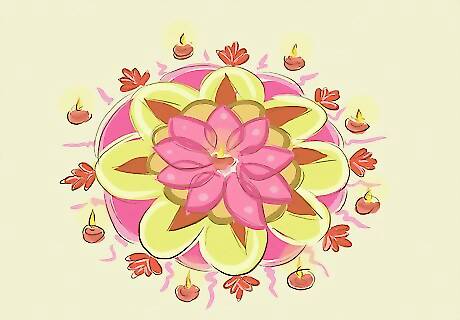
Decorate your home and doorways with rangoli on the second day. Narak Chaturdashi, the second day of Diwali, is typically when people adorn their homes with bright, colorful rangoli designs. Sketch out your design on a piece of transparent parchment paper, then sprinkle sand or dried rice over it. To add some color, buy colored rice or sand at a craft store or dye your materials using food coloring. Rangoli is a traditional work of art and decoration done in sand or rice, often depicting beautiful, symmetrical flowers like lotuses and daisies. Rangoli designs are typically placed just inside the entryway of your home, but feel free to set them up elsewhere, too. You can also paint or draw your rangoli designs on paper or wood, or even buy them pre-made.Tip: Make your rangoli designs even more festive by placing stones, mirrors, or beads around or inside of them.
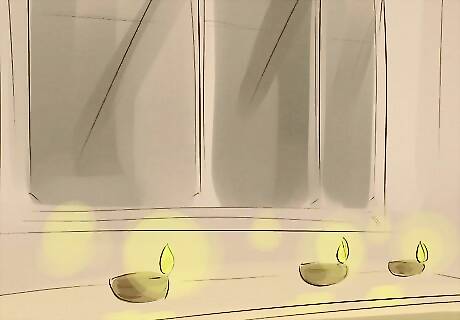
Light diyas and candles around your home, especially in the doorways. Diyas are small oil lamps shaped like cups with cotton, candle-like wicks. To welcome the goddess Lakshmi into your home, it’s traditional to light 4-6 diyas in a row near the doorways, often around your rangoli designs. You can also use small tealights instead. Diyas and candles are often placed on the floor, but you may choose to place them up higher if you have pets or small children. Diwali is the Festival of Lights, so feel free to place candles and diyas in other places around your home as well! You can buy diyas online and even decorate them with recycled materials.
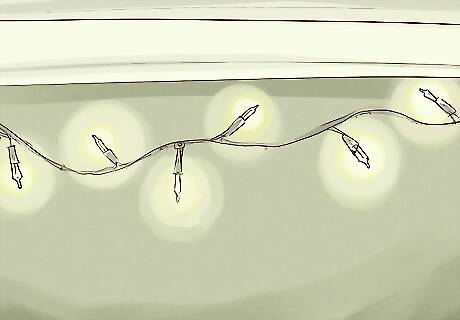
Hang string lights around your home to make it bright and festive. To celebrate the Festival of Lights, make your whole home bright! Hang string lights throughout your house, lining them along the walls and intertwining them through tables and mantels. You can also hang up lights outside, along your roof and fences. You can hang plain white lights or go with colorful strings.
Making Diwali Meals and Treats
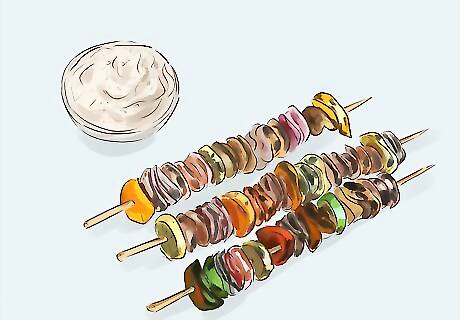
Make snacks and appetizers like kebabs and yogurt dip. There’s no one traditional meal or type of food for Diwali, so feel free to experiment or go with your family’s old favorites. For snacks and appetizers, try options like dahi ke kebabs and yogurt dip with chips or bread. You can make dahi ke kebabs by mixing together plain yogurt, chopped coriander, chopped green chilis, chopped onions, chickpea flour, and cumin seeds, then chilling them for an hour. Shape the mixture into flat circles and fry them in oil or butter until they’re brown on both sides. For yogurt dip, you’ll combine a shredded, salted cucumber with whole milk yogurt, red onion, lime juice, and several spices.

Go with a masala dish for a simple, savory main course. You can’t go wrong with a tasty masala for your main course. “Masala” stands for a mixture of spices often used in Indian cooking, and you can make lots of variations of it, including a vegetarian paneer butter masala, chickpea masala, or chicken tikka masala. To make your masala, you’ll cook your main ingredient (either meal or vegetables) in a deep skillet with milk and spices like curry, coriander, and cumin.Tip: Many people choose to go or remain vegetarian for Diwali, but the choice is up to you.
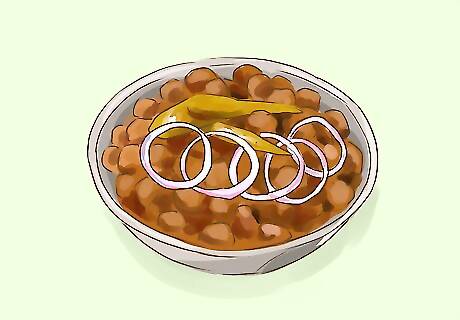
Make pindi chole for a spicy dish. Indian dishes are known for being spicy! If you want a little bit of kick on your menu, whip up some pindi chole, made by simmering a mix of spices and chickpeas in a thick, creamy sauce. To make pindi chole with chickpeas: Cook pre-soaked garbanzo beans in a pressure cooker with 3 black tea bags until they’re cooked through, then drain the water. Using a wok over medium heat, dry roast whole spices like black cumin, carrom seeds, and dry pomegranate until they’re browned, then grind them. Saute garlic ginger paste in the wok for a minute, then add green chilis, green cardamom, pepper, and a bay leaf. Add powdered spices like cumin, coriander powder, and dry mango powder and saute for 2 minutes. Finally, pour in the cooked beans and cook, covered, for 5-7 minutes. Add water and cook until its absorbed, 4-5 minutes, then serve!
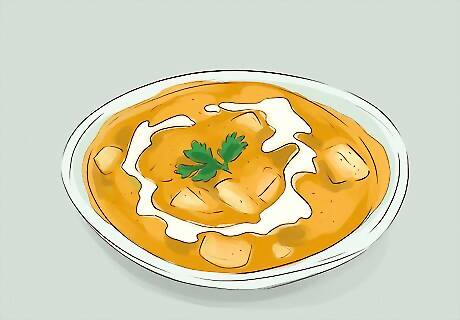
Serve a creamy paneer makhani to add cheesy flavor. Paneer makhani is a satisfying cheese dish that’s perfect for a Diwali celebration. Paneer is just an unsalted version of cottage cheese, so you can substitute it if you like. To make this dish: Saute red chillies, ginger, garlic paste, and whole spices like bay leaves, cinnamon, and cloves for 1-2 minutes in oil or butter. Add cashew nuts, poppy seeds, and onions and saute until the onions are translucent. Add tomatoes and stir, then cover the pan and let it cook until the tomatoes start to break down. Set the mixture aside to cool. Then, remove as many whole spices as you can and use an immersion blender to blend it until it’s a smooth paste. In the same pan, add butter, curry paste, garam masala powder, chili powder, turmeric, ketchup, salt, and water. Bring it to a boil, then lower it to a simmer for 30 minutes. Cut the paneer into bite-sized pieces and stir it into the mix.
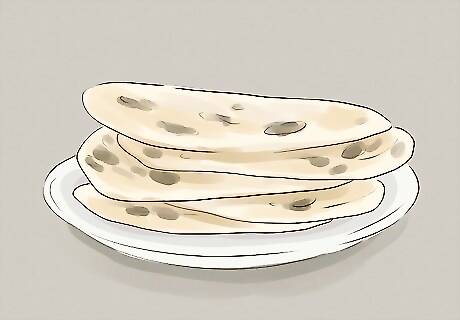
Serve bread like naan on the side. This flat, Indian-style bread is a favorite for all ages. It’s the perfect side to nibble on or calm down your taste buds after a spicy dish. You can make your own naan or buy it in a store. Heat it in the microwave or a toaster first to make sure its warm!
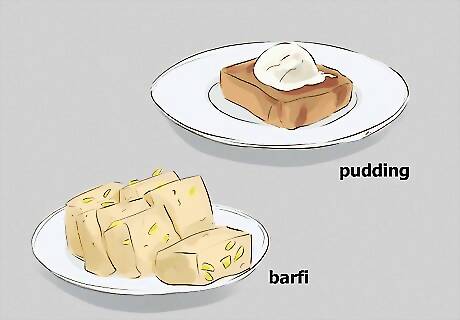
Include plenty of sweets and pastries, like barfi and pudding. As tasty as all the other dishes are, desserts are the star during Diwali! Serve your favorite pastries and sweets, like barfi, a creamy treat made by cooking condensed milk, sugar, and nuts until they solidify, then cut and served in squares. You can also try a dish like kheer, prepared with blanched almonds and raisins and enhanced with some saffron, or a traditional peda. You can try your own hand at making these dishes, or cater from a local Indian restaurant.
Celebrating with Friends and Family

Invite family and friends over on the third day of Diwali. No Diwali celebration is complete without spending time with your loved ones. If you can’t spend time together on each day of Diwali, try to get together on the third day, which is considered the most significant day of the festival. Invite them over to enjoy a meal and some sweets, then take the time to catch up and enjoy each other’s company. On the third day, many families also gather together for Lakshmi puja, a prayer to the goddess Lakshmi as well as Ganesh, the god of wisdom, and Kuber, the lord of wealth. If you’re away for Diwali, text your family and friends to wish them a good celebration and tell them how much you love them!
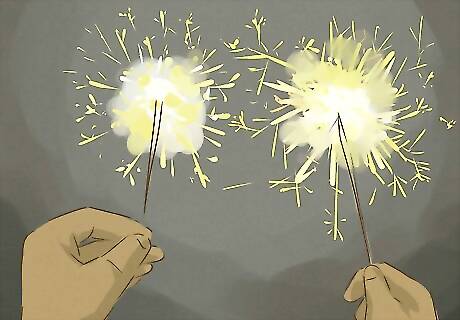
Light sparklers together. Fireworks, firecrackers, and sparklers are always a big part of Diwali, especially on the third day, bringing together the festive spirit and bright, colorful lights of the holiday. If you can, buy handheld sparklers to light outside and enjoy with friends and family. Swirl them carefully in the air to make pretty designs and effects! Setting off private fireworks and firecrackers is illegal in most regions.Warning: Always use sparklers with extreme caution. Keep a bucket of water nearby to put them out when they start to burn down, and dispose of them following the instructions on the packet.

Exchange gifts on the fourth day. Padwa, the fourth day of Diwali, is the official first day of the new year! On this day, it’s traditional to visit your family and friends to exchange gifts and greetings. The gifts don’t have to be anything big—many families give sweets or small items. The most important part is simply appreciating each other.

Celebrate with siblings for the final day of Diwali. Bahu-dooj, the fifth and last day of the festival, is dedicated to the bond between siblings. Traditionally, brothers will visit their sisters, who will put a “tilak,” or vermilion mark, on their forehead to symbolize their love. Brothers, meanwhile, will give their sisters gifts, goodies, and blessings. If you can, visit your siblings in-person or give them a call to check in and show your love for each other.
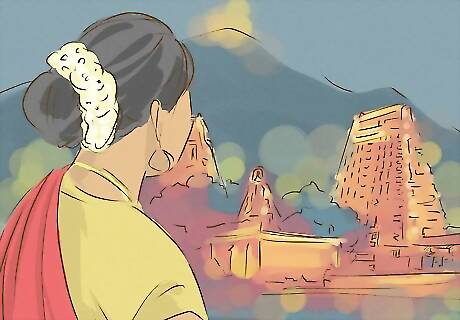
Join in at public Diwali celebrations. Diwali is celebrated all over the world. Even if you can’t be at one of the big celebrations in India, Singapore, and other South Asian countries, there are typically celebrations in most major metropolitan areas. Look online for festivities near you and head out to watch fireworks, enjoy sweet and savory treats, and take part in the celebration! The U.S., Canada, the U.K., and Australia all have large Diwali celebrations.

















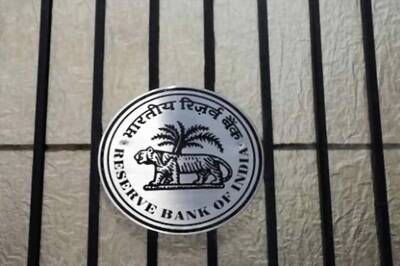
Comments
0 comment